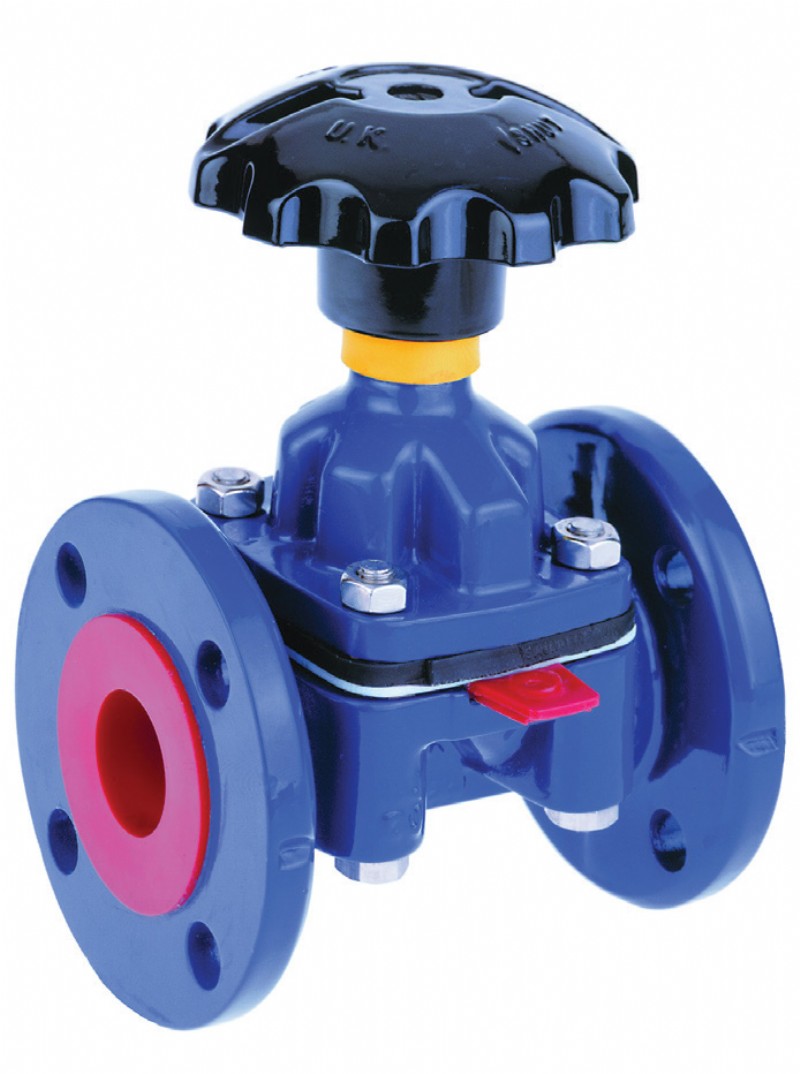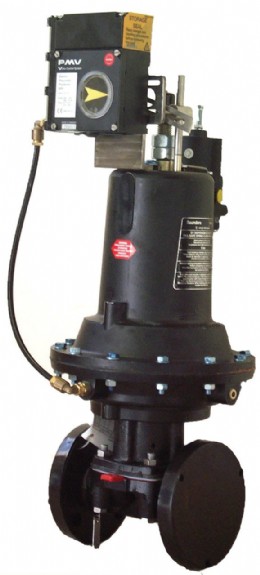Diaphragm Valves for Control Applications

Saunders® on/off industrial diaphragm valve

Saunders® control diaphragm valve utilizing a PMV EP5 Electro-pneumatic positioner
An important regulating element of any control loop within a processing plant, the control valve works with other parts of the loop to ensure the programmed parameters of the process variable (e.g. pressure, flow, temperature, or fluid level) remain within a required operating range.
Control valve and control loop assembly specification is typically based on performance characteristics such as speed, precision, and stability. However, the selection of the most appropriate control valve for a specific location is also governed by the nature of the process fluid. Traditional control valve technology is often restricted to use on “clean” fluids, and is not suitable for services which include the presence of slurries or abrasives. In addition, incorrectly tuned or “over specified” control valves can lead to operational wastes and inefficiencies.
Control Valves
The selection of the most appropriate control valve for a specific plant location is governed by basic process parameters, e.g. the nature of the fluid, temperature and pressure of the system, the flow rate, and the pressure drop. Safety, reliability, and maintenance are also important aspects which subsequently influence the engineer’s choice of valve for a particular process.
The globe control valve, or sliding stem valve, is the most commonly used control valve. Offering the greatest range of control, it moves/pushes an element of the valve into a closed position. Some of the benefits and factors behind the widespread use of this valve type include:
• A high pressure and temperature rating
• Variable trim geometry to suit the required valve characteristics
• Relatively simple actuation and actuation control.
However, use of globe control valves in highly corrosive services requires expensive valve materials and such technology is not typically suitable for abrasive services. In addition, globe valves are not necessarily designed to provide 100% shut-off, rather various degrees of leak-tightness are available, and often an inline “companion” shut-off valve is needed to provide complete closure when required.
Quarter-turn, or rotary valves, on the other hand, feature a rotating closure element (i.e. ball, disc or plug), that when rotated 90 degrees, completely closes or opens the valve. They have become a popular alternative to sliding stem valves in control applications, despite not offering the same level of control. Generally quarter turn valves are smaller in size and weight than linear valves, and they also address some of the limitations of globe valve technology:
• Handling of corrosive fluids
• Tight shut-off capabilities
• The ability to handle high flows and lower pressure drops.
Diaphragm Valves
PK Saunders invented the diaphragm valve in 1929 consisting of three main components: the body, the diaphragm and the operating mechanism. The diaphragm is the dynamic component which restricts or isolates the media flow, and the original valve design included a “weir” in the valve body over which the media flows and against which the diaphragm seals. A straight-through (or full bore) design was subsequently introduced as a valve for handling solids, and both designs can utilize a wide range of different diaphragm and lining materials.
Simplicity of design, coupled with more than 85 years of innovation, has resulted in the diaphragm valve’s ability to handle a wider range of fluids than any other valve type. However, the diaphragm valve’s success as an on/off valve has meant that its ability to operate as a modulating control valve is often over-looked. There are a number of performance features that make diaphragm valves a viable alternative to traditional control valve technology, particularly in 'tough' abrasive or corrosive applications:
• The weir type valve’s inherent linear flow characteristics. Throttling and control characteristics are enhanced by a streamlined flow path that is cavity free and provides excellent flow control capabilities. The straight-through design also demonstrates a linear flow characteristic, albeit within a more limited range of travel.
• Under both positive pressure and vacuum services (from 1 x 10-5 torr to 16 bar, valve size dependent), diaphragm valves deliver 100% leak-tight shut off in accordance with standard BS EN 12266-1. This performance is maintained even after thousands of operations and with solids present in the line.
• The lack of stem packing or glands minimizes potential leak paths. The diaphragm forms a natural seal between the operating mechanism and process fluid, isolating the valve’s working parts from the line media.
• A wide range of valve body, valve lining, and diaphragm material options ensure suitability for use on abrasive and corrosive media. These material options provide an effective and economical solution by eliminating the need for the exotic alloys used in alternative valve technology.
• In a similar fashion to the rotary valve, diaphragm valves demonstrate a high flow capacity, particularly when compared against globe valve technology.
• A wide range of ancillaries can be attached to diaphragm control valves to meet the plant requirements and maximise operational efficiencies. Pneumatic, electro-pneumatic, intrinsically- safe, explosion-proof and smart positioners are available with features including characteristic cams which are able to alter the valve performance to produce the desired flow profile.
• The relatively low purchase price and maintenance costs of the diaphragm valve ensure value. During servicing the valve can be disassembled without having to remove the body from the pipeline.
Case Study
Industry & Location: Chlor-alkali, India Plant(s): Cell House, HCl Plant, Chlorine Liquefaction, Brine Preparation Media: Chlorine Water, Sodium Hypochlorite, Hydrochloric Acid, Brine, Demineralised Water Valve specifications:
• Weir type
• DN20 – DN80
• Plastic (PVDF or ETFE) and hard natural rubber linings with two-piece PTFE faced diaphragms. For the most severe services, the three-piece PTFE diaphragm, including PVDF interlayer, was utilised
• Fail-to-close and fail-to-open diaphragm operated actuators with either explosion proof or weather proof Electro- Pneumatic positioners
Control Purpose(s): Flow Control, Level Control
A key industry/application for diaphragm valves, the existing manual and actuated valve installed base at this end user was successfully extended to include diaphragm valve control valves. The originally installed butterfly valves demonstrated poor flow control, resulting in the plant repeatedly “tripping”. In addition, with the only solution being direct one to one replacement, the maintenance costs for such valves were significant. As a result of the highly corrosive nature of the fluids to be handled, material selection for both linings and diaphragms was advised on an individual line basis. Sizing of individual valves, to accommodate factors including process conditions and pipe sizes, enabled a complete package of manual and actuated control valves to be installed on site (in 2008), where they have worked well without issue, to date.
Conclusion
There is not one single valve type suitable for use in every service, and this holds particularly true for control applications. Over specification is incredibly wasteful and the performance accuracy of the installed control valves should exactly match the required degree of control. The diaphragm valve has been presented as a viable alternative to “traditional” control valve technology, where the strengths of the diaphragm valve as an on/off valve can be equally applied in control applications:
• Suitability for use on corrosive/abrasive fluids (wide range of diaphragm and lining options)
• Leak tight shut off even with solids present
• Relatively low cost (both purchase price and ownership costs)
• In-line maintenance capabilities
Albeit a versatile option, it should be highlighted that the diaphragm valve is suitable only for use on services which fall within the natural temperature and pressure windows of operation, as they are heavily influenced by the valve materials and linear valve movement. However, continual innovation from diaphragm valve manufacturers has led to developments and improvements in diaphragm valve materials, actuators and accessories. As a result, the potential window of operation has been expanded to include higher temperature and more severe services (in terms of corrosion and abrasion), and is therefore greater than ever.
This article was written and supplied by David McClymont, Saunders® Industrial Diaphragm Valve Application Specialist, CRANE ChemPharma and Energy, a Crane Co. business.
Tel: +44(0)1633 486666
Email: news@cranechempharma.com
Web: www.cranecpe.com

| Telephone: | 01633 486 666 |
| Email: | news@cranechempharma.com |
| Website: | www.cranecpe.com |
| More information on the Crane ChemPharma & Energy, Saunders BVAA Member Directory Page |
Search related valve / actuator articles: Crane ChemPharma & Energy, SaundersIssue 41ValvesDiaphragm Valves / Pinch ValvesMaster Class







-web.jpg)





